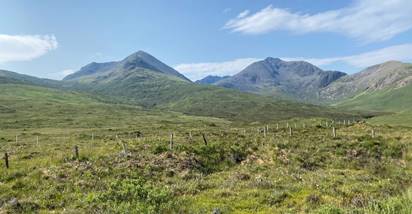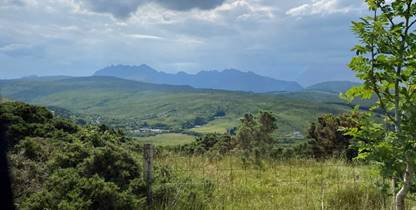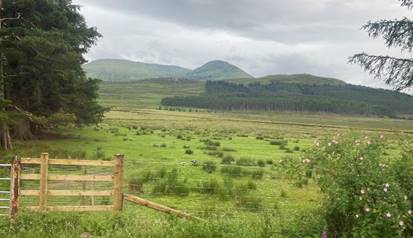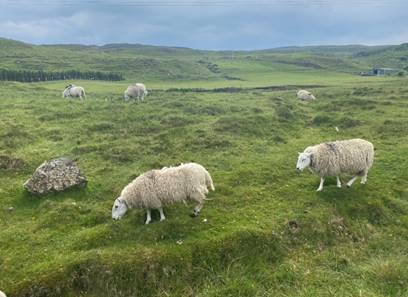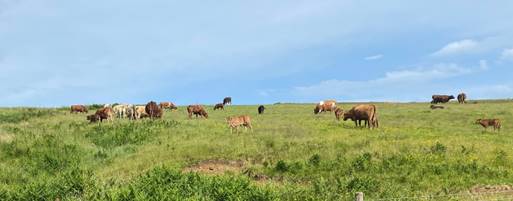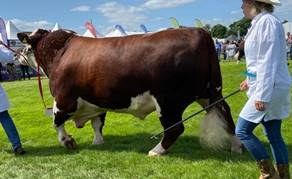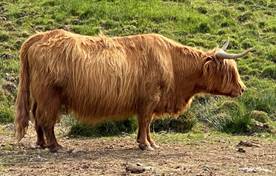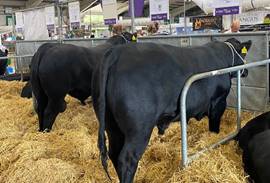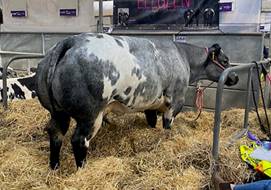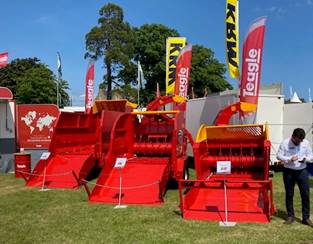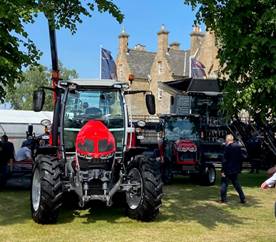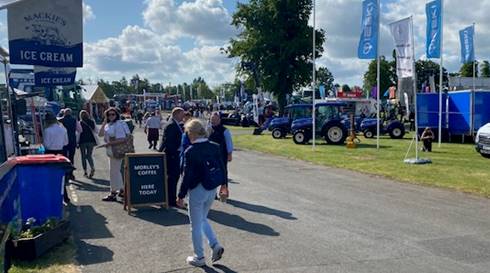Cow-Calf Corner | June 26, 2023
Scotland and the Royal Highlands Show
Derrell S. Peel, Oklahoma State University Extension Livestock Marketing Specialist
I’m finishing up a study abroad trip with students from Oklahoma State University visiting Ireland and Scotland.
Scottish GrasslandsHere are a few scenes of the expansive grasslands in Scotland that support livestock agriculture.
We visited the Royal Highland Show…sort of a massive state fair…lots of agricultural machinery and cattle...some familiar and some not so familiar. It’s not often you see modern machinery against a backdrop of historical architecture.
Royal Highland ShowScotland has a vibrant agricultural industry that operates against a long and rich historical backdrop.
Historical Review of the U.S. Beef Cattle Industry – Part 1
Mark Z. Johnson, Oklahoma State University Extension Beef Cattle Breeding Specialist
As we prepare to celebrate Independence Day, (hopefully with family, friends and delicious beef along with the fireworks), it seems appropriate to reflect on the history of the U.S. beef industry. The history is colorful, interesting and can be helpful in planning for future success.
How It Started
Although many breeds of cattle are in the United States, none are native to this country. The first cattle were introduced by explorers and settlers from Spain and England centuries ago. For over 200 years the U.S. cattle population was Longhorn based. Open range, the ability of the descendants of Spanish Longhorn cattle to thrive in a feral environment and their meat value eventually created an industry. By the end of the civil war the longhorns had reproduced exponentially and millions of head roamed the open ranges of the U.S.
Shorthorn cattle were first introduced from England to Virginia in 1783. The first herdbook to record ancestry of Shorthorn cattle was established by George Coates in 1822. The American Shorthorn Association was established in 1882. Henry Clay imported Hereford cattle from England to Kentucky in 1817. The American Hereford Association was established in 1881. The American Polled Hereford Association would later become established in 1900. George Grant imported Angus cattle from Scotland to Kansas in 1873 and the American Angus Association was established in 1883. James Davis imported the first Zebu cattle to South Carolina in 1849. Simmental cattle were introduced to the U.S. in 1896 but had little industry impact at that time.
Cattle Drives and the Chisholm Trail
After the civil war, trail drives began and one of the most romanticized eras in our nation’s history was born. It was at this time that Americans acquired a taste for beef and the Chisholm Trail was considered to be one of the wonders of the western world. Herds with as many as ten thousand cattle were driven from Texas over the trail to Kansas. The trail acquired its name from Jesse Chisholm, who just before the Civil War had built a trading post in what is now western Oklahoma City. During the Civil War, while many Texans were away fighting for the Confederacy, descendants of the Spanish Longhorn cattle multiplied. By 1866 they were only worth four dollars per head in Texas. In the North and East they could be worth $40 – 80 per head. In 1866 some herds traveled the Shawnee Trail in eastern Oklahoma, but the woods and the region's rough terrain discouraged trail driving.
In 1867 Joseph McCoy built stockyards on the Kansas-Pacific railroad in Abilene, Kansas. He sent men south to encourage Texas cattlemen to send herds to his stockyards. He also encouraged cattle buyers to come to Abilene, where cattle would be waiting. Drovers followed assorted minor trails through south and central Texas northward to the Red River crossing and then joined the famous Chisholm Trail. After being driven north along the Chisholm Trail to Abilene, the cattle were shipped east to the beef packers and population centers.
Herds varied in size from 500 to 10,000; however, they usually averaged from 2,500 to 3,000 head. A rancher entrusted his herd to a trail boss, who would hire 10 to 15 cowboys, a cook and wagon, and a wrangler (horse handler) for the 100 to 150 horses. The trail boss would also provision the wagon and plan the drive. On the trail the cattle were watered in the morning, and then they slowly ate their way northward. The cowboys kept them from stopping, turning back, or leaving the herd. The herd would walk about ten miles per day, stopping only to water and eat. At night, the herd would stop at a watering hole and bed down. These herds were less than ten miles apart and were spaced so that each herd could spend the night at a watering point. At the Abilene railhead the trail boss would sell the cattle and horses, pay the cowboys, and return to Texas with the money for the owner, often repeating the trip year after year.
Eventually the Chisholm Trail would stretch eight hundred miles from South Texas to Fort Worth and on through Oklahoma to Kansas. The drives headed for Abilene from 1867 to 1871; later Newton and Wichita, Kansas became the end of the trail. The Cimarron cutoff on the north side of the Cimarron River allowed cattle to be driven to Dodge City, Kansas. From 1883 to 1887 herds headed up the trail to Caldwell, Kansas, making it the last great cow town on the trail.
The biggest cattle trailing years were 1871 and 1873. After 1881 the drives diminished considerably. The range was fenced in the Cherokee Strip after 1884, an 1886 Kansas quarantine law (against Texas fever) prohibited the entry of Texas bovines, and in 1887 a blizzard destroyed most of the range cattle industry. The Land Run of 1889 into the Unassigned Lands opened central Oklahoma to settlement, peopling the plains with farmers, who built fences and towns. These factors ended the trail-drive era. An estimated six million cattle had traveled the Chisholm Trail during its life, giving rise to many cowboy legends that survive to this day. By the end of the 1800s, the plains were being re-populated by the British breeds and the selection trend was for cattle with more muscle thickness.
Can Distiller’s Grains Cubes Replace Traditional Supplements for Stockers in the Late Summer?
Paul Beck, Oklahoma State University State Extension Beef Nutrition Specialist
The quality of native range declines during the late summer drastically reducing performance of stocker calves during the late summer. The Oklahoma SuperGold Program was designed to meet protein, energy, and mineral deficiencies for steers grazing native range in the late summer using grain milling byproduct based supplements. Feeding 2.5 lb/day of a mid-protein (25% crude protein) supplement including an ionophore increases gains by 0.7 lbs/day adding a pound of gain for every 3.6 pounds of supplemental feed.
Recently an extruded distiller’s grains cube has become available in the region. Research by Jordan Adams at Oklahoma State University showed that the extrusion process decreased the fiber content while increasing the crude protein, fat and TDN content of the distiller’s grains; and increasing flexibility by enabling feeding directly on the ground.
A series of experiments by OSU graduate student, Zane Grigsby, on native grass prairie sites at the USDA Southern Plains Range Research Station near Fort Supply and the OSU Marvin Klemme Range Research Station near Bessie investigated using distiller’s grain cubes in an Oklahoma SuperGold supplementation program for growing steers with mineral supplements containing ionophores offered free-choice in a separate complete mineral mix.
Supplementation Rate
| Study | Negative Control | 2 lbs/day | 4 lbs/day | 6 lbs/day |
|---|---|---|---|---|
| Fort Supply, OK year 1 | 1.18 | 1.91 | - | - |
| Fort Supply, OK year 2 | 1.83 | 2.93 | - | - |
| Ft Supply, OK year 3 | 1.69 | 1.91 | 2.11 | 2.33 |
| Ft Supply, OK year 4 | 2.05 | 2.17 | 2.29 | 2.40 |
| Bessie, OK year 1 | 1.07 | 1.69 | 2.31 | - |
| Bessie, OK year 2 | 1.00 | 1.83 | 2.66 | - |
| Average Response | 1.47 | 2.07 | 2.34 | 2.36 |
Table 1. Performance of Growing Steers Grazing Native Range Pastures when Supplemented during the Late Summer with Extruded DDGS Cubes in Western Oklahoma.
On average, supplementing with 2 pounds per day during the late summer increased gains of steers by 0.6 lbs/day, requiring 3.3 pounds of feed per pound of added gain. Feeding additional supplement increased gains but with decreasing supplemental efficiency. These higher feeding rates have the potential to increase stocking rates on pasture as we have seen with previous research. Supplementation of grazing calves during the late summer can be highly profitable even in years with high input costs.
References
Adams, J. M., et al. 2022. J. Anim. Sci. 100:1-11 skac097
Grigsby, Z. N., et al. 2023. J. Anim. Sci. 101(Suppl. 1):84-85. (Abstr).
Grigsby, Z., et al. 2022. J. Anim. Sci. 100 (Suppl. 3): 174-175 (Abstr.)
Grigsby, Z. N., and P. A. Beck. 2022. J. Anim. Sci. 100 (Suppl. 1):38-39 (Abstr.).

